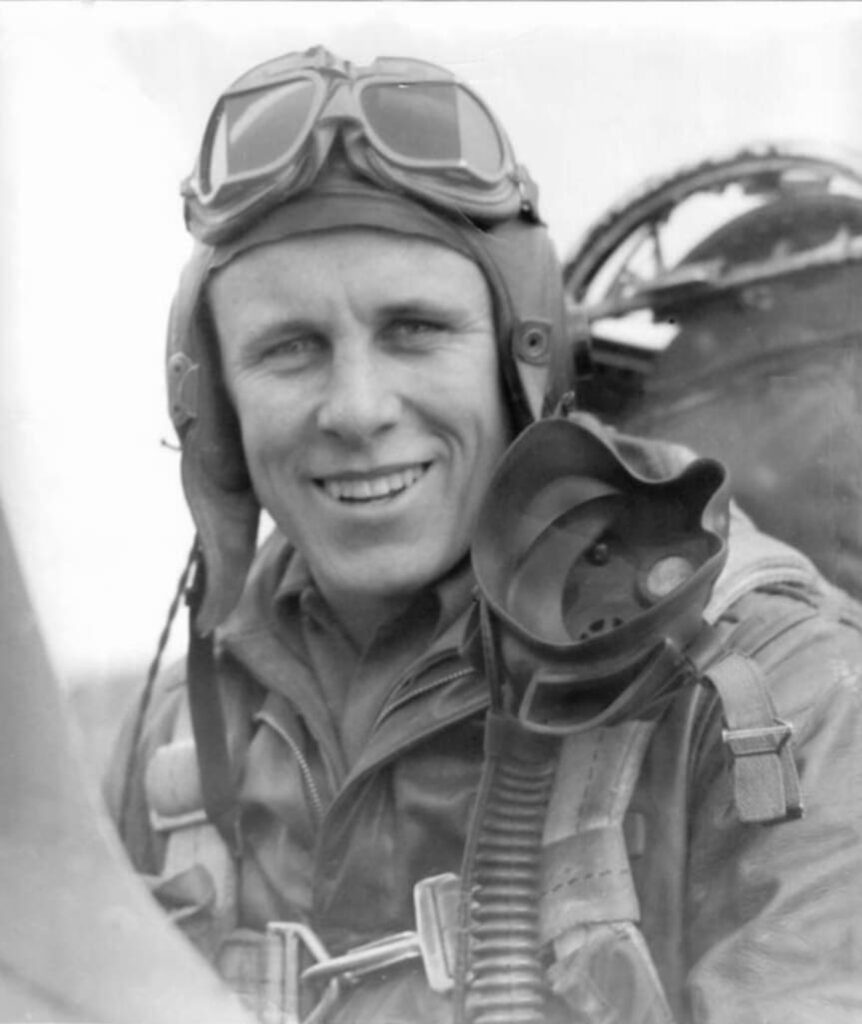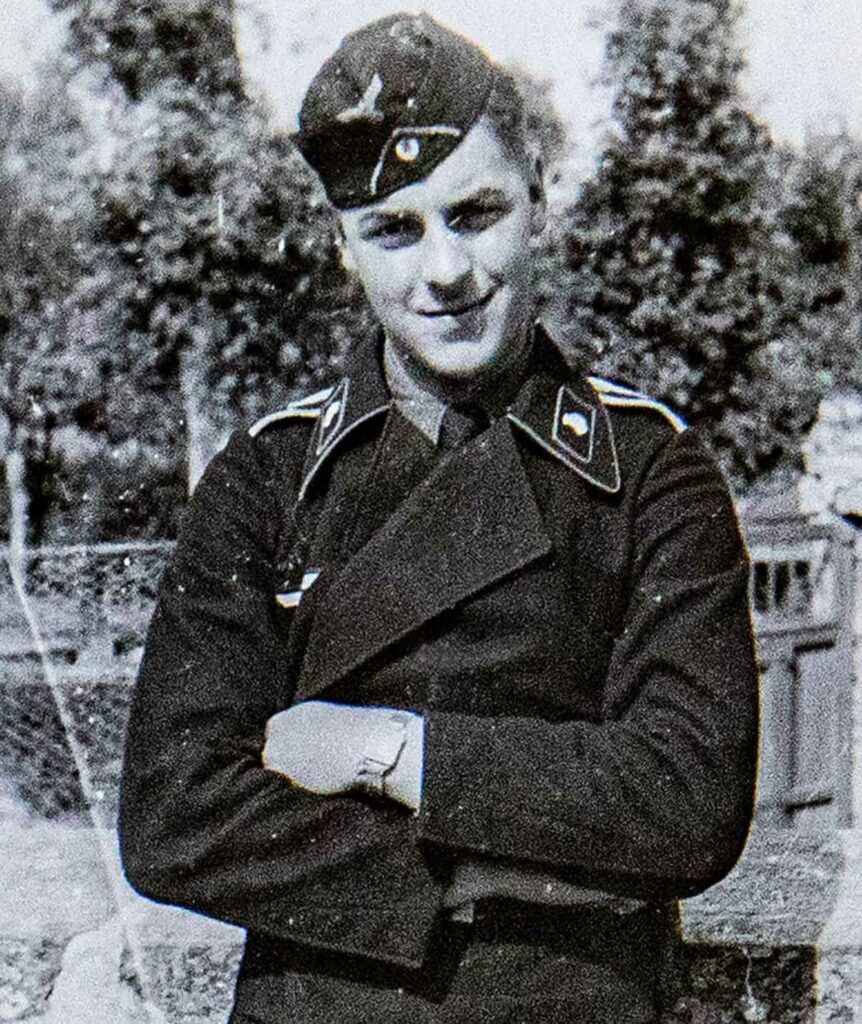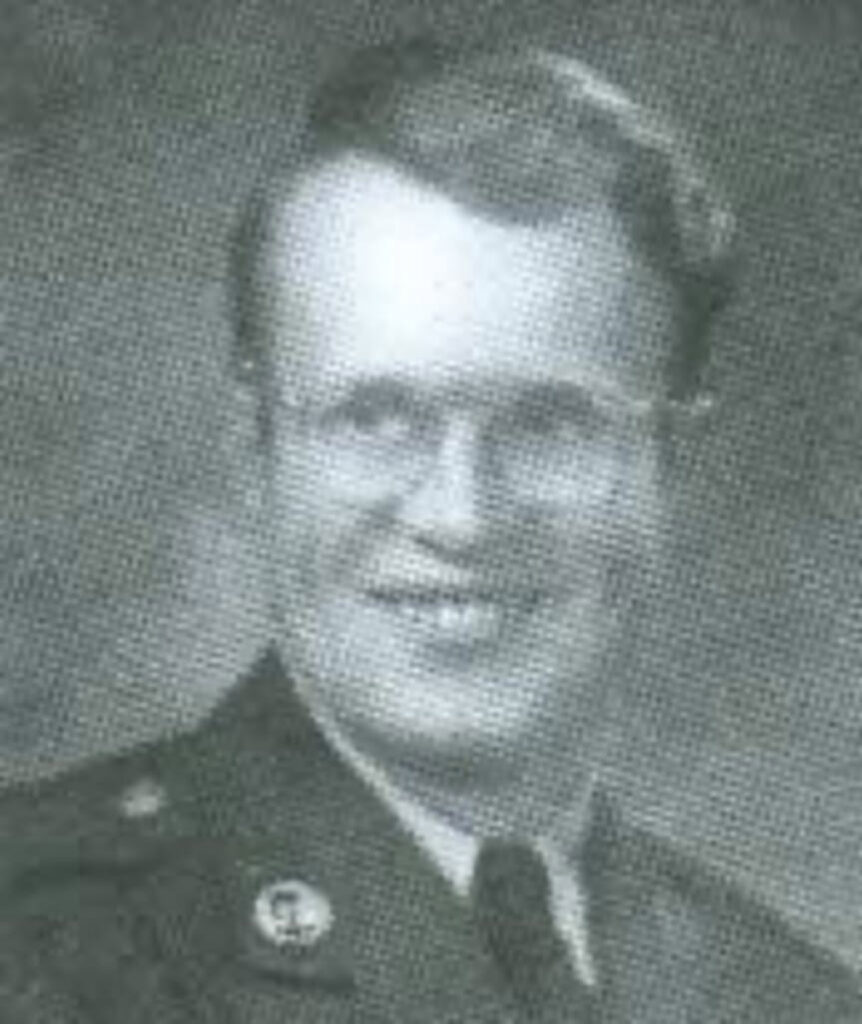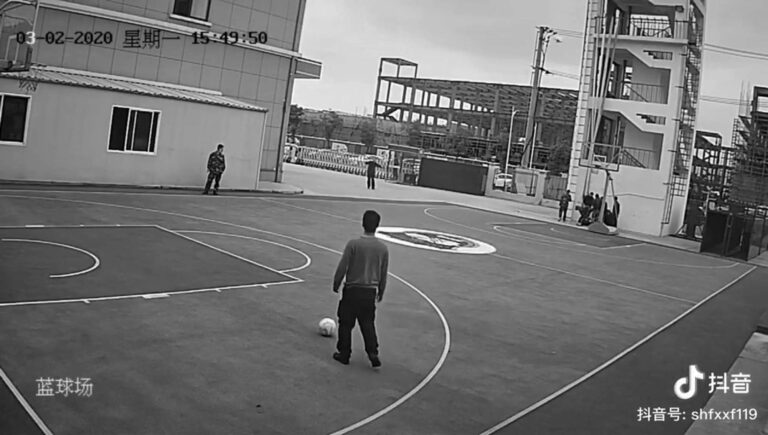Two World War II veterans who fought on opposite sides in a battle that marked a turning point in the conflict are seen here sharing a joke after the former American fighter pilot told the German tank commander he was happy he missed him so “we can be friends today”.
Former American fighter pilot, Ed Cottrell, 99, who flew a Thunderbolt and participated in 65 missions against German troops, shared a beer and sauerkraut with his new German friend Dr Juergen Tegethoff, 97, who used to be a tank commander in the battle for the bridge at Remagen.
The battle in which Tegethoff had the rank of lieutenant in the German Wehrmacht later became a Hollywood film.
The American told local newspaper Bild that the tanks were a fearsome opponent saying: “The only thing we knew was that the tanks were so robust that bullets could not damage them – only bombs.”

Ed Cottrell as a young pilot – was flying a P-47 fighter aircraft. (Newsflash) 
Ed Cottrell, 99, knelt to honour his friend Ted 77 years after his death at the Belgian military cemetery. (Newsflash)
And when the former German tank commander was asked if they had any weaknesses he jokingly replied that you had to catch them from behind, before adding dryly: “But we didn’t write that on the tank.”
The Thunderbolts were a series of various American military aircraft developed between 1941 and 1945. They were used in both the European and the Pacific theatres. Cottrell flew a P-47 Thunderbolt, which was designed for dogfights at high altitude and for attacking targets on the ground.
The pilot was ordered to attack a bridge that was defended by the German tank commander and now the soldiers have visited the remains of the Bridge at Remagen (formerly “Ludendorff Bridge”) together.
During action that led to the film ‘The Bridge at Remagen’ being made in 1969, the bridge collapsed on 17th March 1945, some 10 days after soldiers from the 9th Armoured Division seized it, allowing the First United States Army to cross it. That event, among others, signified the collapse of the German army’s western front, allowing the Allies to invade Germany.
Cottrell, who fought until 1945 while his pregnant wife waited for him back home in the United States, said: “I shot at the ‘Ludi’ (Ludendorff Bridge, ed.) and then I defended it. In between, I hunted Juergen’s King Tiger. I’m glad I didn’t aim that well, so we can be friends today.”

The King Tiger (“Koenigstiger”) was the heaviest tank built by the Nazi regime during the war. Cottrell asked the former German tank commander what the best way would have been to neutralise the massive tank, which were notoriously difficult for the Allied troops to destroy.
Tegethoff replied dryly: “Catch it from behind.”
The meeting also involved three other former American soldiers. The images show the veterans talking, smiling and joking some 77 years after the bloody conflict that tore Europe, and much of the rest of the world, apart. But on this occasion, the Americans and the Germans were enjoying a warm cup of coffee at the military cemetery of Ittenbach, which is located in the south-western German state of North Rhine-Westphalia.
It took years to set up the meeting, with it being postponed numerous times for a multitude of reasons. But they all agreed that it was well worth the effort, according to German daily Bild.

Tegethoff met with the four American veterans, including Cottrell, as well as Al Bucharelli, 98, who lost his left leg in in Monte Cassino in Italy in 1944, Bob White, 98, who was a paratrooper, and Al Blaney, 96, who was a paramedic in the 326 Medical Company that was part of the legendary 101st Airborne light infantry division.
The famous 101st Airborne, popularised in recent years by films and TV shows including Band of Brothers, participated in the Allied invasion of Europe, from the beaches of Normandy on D-Day to the taking out Hitler’s Eagle’s Nest in the Alps towards the end of the war. Blaney said: “When I last left Germany in 1948, I was sure I would never return. But now I had the opportunity. I don’t know what the future will bring. Maybe I don’t want to know.”
Among the iconic moments they shared in laughter during their encounter is one when Tegethoff is asked how he went to the loo when he was in the tank. His reply: “An empty grenade shell was passed around – and then out with it through the hatch!”
Bucharelli, who was a soldier in the 3rd Infantry and who returned to the United States on a hospital ship after losing his leg in Italy, told Bild: “We don’t need anniversaries as reasons to meet up. We’re running out of time to tell our stories and to listen to each other’s.”
Tegethoff met White and “Doc” Blaney two years ago in 2019, in the Belgian town of Bastogne, which had featured in the Battle of the Bulge. Blaney said: “I took care of anybody who was wounded, regardless of which side they are fighting for.”

He also said that he was “happy to see Juergen again.”
They drank beer and ate sauerkraut and an iconic photo showing them shaking hands over the dinner table in 2019 now reportedly hangs in the living rooms of many US veterans and their families, according to the German daily.
Tegethoff, who Bild said worked as a public official after the war, recalled: “I was greeted in a very friendly way. Even though I was a bit scared at first.”
During this latest encounter, Tegethoff took the four US veterans for a ‘koelsch’, which is a type of beer from Cologne. The name of the restaurant: ‘Wacht am Rhein’, which translates as ‘Rhine Watch’.
Bild explained that the name is symbolic as it is also the name of a famous German song from the imperial era that was used as the codename for the counteroffensive the Nazis undertook in a bid to push back the Allies in the Ardennes.
The former German tank commander also passed around an old photo album that he had kept from his war days. He had managed to hide it from advancing American soldiers the final weeks of the conflict in 1945. The American soldiers looked at the album, which included maps detailing the German counteroffensive, with interest, with Tegethoff raising his glass and saying: “Never put off until tomorrow what you can drink today!”

For Cottrell, this trip to Europe is particularly significant. He said: “I am 99 years old. I don’t think I’ll ever come here again.”
He had reportedly been searching for one of his best friends for 77 years after he died during the bloody conflict. Bild reports that this search has now come to a close, notably thanks to a young Afghanistan war veteran called Andrew Biggio, 33, who wrote the book “The Rifle”.
Indeed, on this trip to Europe, Cottrell has at last found the final resting place of his friend, Ted, in a Belgian cemetery.
He told Bild: “On 1st January 1945, our squadron was sent on a mission. My friend Ted was the leader of the squad, consisting of four aircrafts. He was hit by anti-aircraft missiles. He pulled up the plane, but it wasn’t enough to escape. He crashed and was killed.”
During their encounter, Tegethoff also said: “How could they have incited us against each other like that? How could we have participated? We must tell people about this for as long as we can.”

To find out more about the author, editor or agency that supplied this story – please click below.
Story By: Joseph Golder, Sub-Editor: Joseph Golder, Agency: Newsflash
The Ananova page is created by and dedicated to professional, independent freelance journalists. It is a place for us to showcase our work. When our news is sold to our media partners, we will include the link here.




